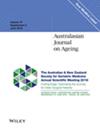Relationship of frailty and postoperative complications in older people who underwent radical surgery for a gastrointestinal tumour
Abstract
Objective
Frailty is associated with postoperative complications in older people with gastrointestinal malignancies. However, the relationship between frailty and complication severity, as well as the risk factors for complications after radical surgery, is still unclear.
Methods
Frailty was assessed using a modified Frailty Index (mFI) score, and the correlation between frailty and postoperative complications was compared between frail and non-frail groups. Complication severity was evaluated using the Clavien–Dindo (C-D) system, and independent risk factors for postoperative complications were identified through odds ratios (OR) using multivariate logistic analysis. The participants were divided into non-frailty and frailty groups based on the mFI.
Results
The frailty group had fewer patients aged 60–69 years (19% vs. 31%, p = .03) and a higher incidence of moderate CCI (52% vs. 69%, p = .001). Frailty was strongly linked to postoperative complications, including pulmonary infections (16% vs. 8%, p = .009), pulmonary embolism (8% vs. 3%, p = .02) and acute kidney injury (14% vs. 6%, p = .005). Older frail patients experienced more severe complications, with higher rates of C-D grade III (23% vs. 10%, p = .004) and grade V (6% vs. 1%, p = .004). Multivariate analysis found that frailty (OR: 1.492, p = .02), age greater than 70 years (OR: 1.239, p = .04) and severe comorbidities increased the OR of severe complications. Additionally, frail patients had poorer recovery, with higher in-hospital mortality (4% vs. 0%, p = .01), more ICU readmissions (11% vs. 3%, p = .005), longer stays (9 vs. 8 days, p < .001) and higher costs (48,035 RMB vs. 43,792 RMB, p < .001).
Conclusions
Older frail adults experienced more severe complications and had worse postoperative recovery.

 求助内容:
求助内容: 应助结果提醒方式:
应助结果提醒方式:


